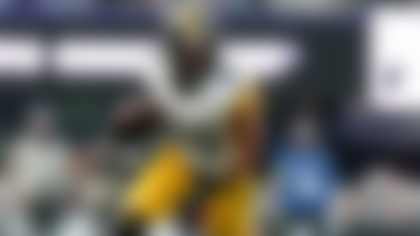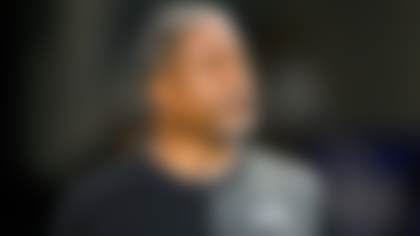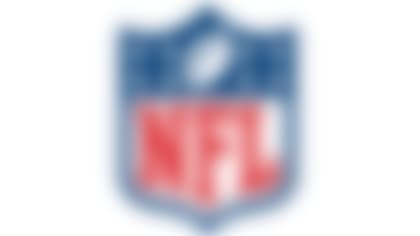The league's top-rated offense is rounding into form heading down the stretch, with four key components that make them a legitimate threat to dethrone the champs. Let's take a look ...
1. Tempo
The frenetic pace of the Saints' offense keeps opponents on their heels. The constant shuffling of personnel combined with a myriad of formations and pre-snap movement makes it difficult to get a bead on their plan of attack. Drew Brees adds to the confusion by pushing the pace with a mixture of no-huddle and quick snap counts designed to keep the defensive coordinators from substituting personnel or varying their play calls for fear of a miscommunication error leading to a big plays.
Against the Giants on Monday, the Saints' organized chaos tactics led to receivers running free through zones and defenders failing to stay in their assigned gaps on running plays. The Giants frequently failed to identify the proper strength of the offensive formation, and defenders were left scurrying to get to their assignments prior to the snap.
In looking at Pierre Thomas' 12-yard touchdown run in the fourth quarter (right), it was obvious Giants defenders were unsure of their alignments and assignments due to the Saints' clever substitution within their "12" personnel package (one RB, two WRs, two TEs). John Gilmore and Pat McQuistan (a backup offensive tackle) were aligned as tight ends, with WRs Robert Meachem and Marques Colston positioned in tight alignments. The close proximity of the receivers combined with the tight formation featuring multiple tight ends confused the defensive play-caller (Deon Grant) and resulted in a free run to the end zone for Thomas.
With few defenses capable of keeping pace, the frenzied nature of the Saints' offensive approach gives them a decided advantage.
2. Drew Brees
After experiencing a sub-par 2010 season, Drew Brees has regained his Super Bowl MVP form. He currently leads the NFL in passing yards (3,689) on the strength of eight 300-yard games and ranks third in touchdowns (27) and passer efficiency (103.9).
In looking at his 11 starts, Brees has completed passes to at least six receivers in each game and had eight or more in eight of those contests. His distribution makes it difficult for defensive coordinators to use exotic coverage to diffuse the Saints' aerial attack, which opens up the field for Brees.
With his quarterback in zone-like rhythm, coach Sean Payton has been willing to give Brees more opportunities to attack the defense. The Saints' 41.8 attempts per game lead the NFL, and the team's high-octane approach has helped the unit average 31.3 points, the second best total in the league.
Brees' 11 interceptions raise concerns about his ball security. During first few weeks of the season, he routinely forced balls into coverage attempting to generate big plays, but the tightly contested balls frequently resulted in interceptions off tips or overthrows.
During the past five weeks, however, Brees has avoided those challenging throws and reduced his turnover total. He has just three picks over that span and the elimination of negative plays has allowed the Saints offense to thrive. If he can continue to pick apart opponents with a surgeon's precision, the Saints pose a tremendous challenge for any defense.
3. Matchup-problem receivers
New Orleans has a plethora of playmakers that make it easy for Brees to carve up the opposition. From Jimmy Graham to Marques Colston to Lance Moore, the Saints have the ability to create mismatches all over the field. Their premise is to isolate a weak defender in space and repeatedly work the matchup until the defense employs soft zone coverage, which provide easy throwing lanes for Brees.
Graham, the team's leading receiver with 67 receptions for 957 yards and eight scores, has emerged as the pivotal piece on the chessboard. As a former basketball player with extraordinary size and athleticism, he is nearly indefensible in space. He has the ability to post up defensive backs on slants or fade routes, while also possessing the speed to run past linebackers on vertical routes. His unique ability warrants double coverage on most downs, which opens up the field for Colston and Moore.
Colston, second on the team with 45 receptions for 667 yards and three touchdowns, functions as the big-bodied playmaker between the hashes. He excels at making the tough grab in a crowd, and the Saints often run him on inside routes to take advantage of his superior size. While he doesn't possess the game-breaking speed of some of his teammates, his ability to break tackles makes him a dangerous weapon in the open field.
Moore is the valuable slot receiver Brees often turns to when a big first down is needed. His quickness out of breaks makes him tough to guard in isolated matchups, and the Saints routinely design plays to get him the ball quickly on quick outs or option routes.
With Devery Henderson and Robert Meachem able to serve as the designated deep ball threats, the Saints have versatile receiving corps that threatens defenses at every level.
4. An actual running game
The Saints' potent aerial attack overshadows its running game, which could be the biggest component to success down the stretch. Led by Pierre Thomas, Darren Sproles and Mark Ingram, the Saints boast the league's 14th-ranked rush offense, averaging 117 yards per game.
Those numbers aren't impressive at first glance, but the presence of three runners with 400-plus rushing yards forces defenses to respect the run with occasional eight-man fronts. This creates big play opportunities in the passing game off play-action, which leads to quick points for the Saints.
Although creating big plays through the air is an added benefit of having a potent running game, it is the ability to switch styles in the middle of a game that makes the Saints offense dangerous. The unit can morph into a power running team with Thomas and Ingram grinding between the tackles. Both are rugged with a knack for finding creases in traffic, and their persistence wears down weary defenses in the late stages of games.
Sproles' diminutive stature prevents him from acting as the Saints' grinder, but he adds the explosive element to the running game with his speed and quickness. He wreaks havoc on opponents when he gets to the edges, and the Saints use a clever misdirection package to get him loose on the second level. With a variety of touches on fly-sweeps, reverses and flip tosses, Sproles averages 6.8 yards a carry, while producing five runs of 20-plus yards.
With three runners capable of providing power and explosiveness, the Saints' underrated running attack could be a difference-maker heading into the postseason.
Follow Bucky Brooks on Twitter @BuckyBrooks




